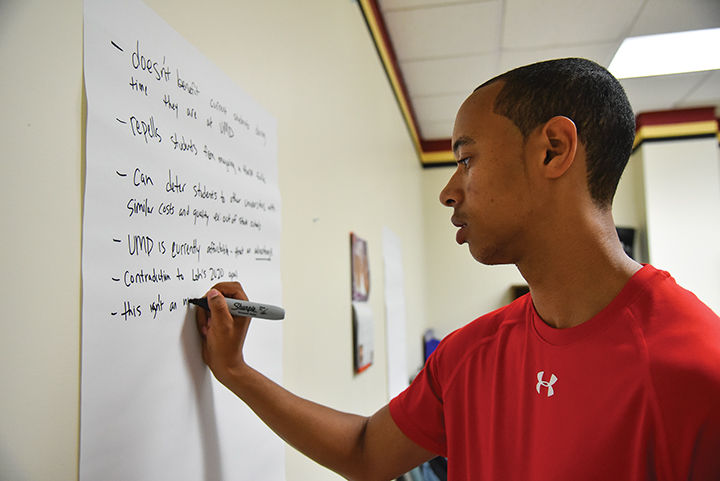
Kirk Morris, a sophomore LTSC student, writes ideas out on paper at a town hall meeting which discussed the pros and cons of the potential tuition increase on May 5, 2015.
After reading in The Diamondback on Monday that this university is proposing gradual tuition increases for business, computer science and engineering majors, sophomore Robert Kornfeld immediately emailed the article to his dad.
“He’s the one paying my tuition; I thought he’d want to know,” said Kornfeld, a materials science and engineering major.
His father told Kornfeld that if this proposal bothered him, he needed to do something about it.
The change.org petition Kornfeld created in response, which asks the University System of Maryland Board of Regents to vote down the tuition increase, surpassed its initial goal of 500 signatures early yesterday afternoon and is now swiftly on its way to 1,000. Other change.org petitions were launched around the same time, each garnering a few hundred signatures.
“I just hope for the administrators to see the student body cares deeply about this issue and they should have consulted us before,” Kornfeld said. “It’s awful to go after these particular students because they’re following their passion.”
The board will vote on whether to approve this university’s proposal for differential tuition pricing, along with a systemwide 5 percent tuition increase, at a special meeting this afternoon.
According to the proposal, the increases would be gradual, with current juniors seeing a $700 tuition increase senior year, current sophomores seeing a $700 tuition increase junior year and a $1,400 increase senior year, and current freshmen seeing a $1,400 tuition increase junior year and a $2,800 increase senior year.
For students who pursue these majors in the future, there will be a $2,800 differential cost for junior and senior year, in addition to regular tuition and fees.
“I hope [the regents] consider the needs of their students,” said Daniel Moscatiello, a sophomore finance major paying out-of-state tuition. “They’re the ones running the university system, but we’re the ones they have to answer to because we’re the ones paying the school to be able to take classes in these programs.”
Beyond signing a petition, students were able to share their opinions on the proposal during a Student Government Association meeting in Stamp Student Union last night.
Fewer than 15 students came into the SGA office, but students who did attend the town hall expressed concern and annoyance regarding the proposal’s short notice.
“The biggest problem with this proposal is the way it came up so suddenly for students,” said senior economics and finance major Raaheela Ahmed, the Board of Regents’ student regent. “I really wish students and faculty and staff had more notice, because I think there’s value in collective decision-making and collaboration.”
Moscatiello said this “added insult to injury,” as this university also implemented a 2 percent midyear tuition increase last semester with little warning.
Ahmed and other students wrote down the main points discussed, and Ahmed said she intends to use the feedback and suggestions during the regents’ meeting today.
This university listed a host of reasons for the differential price structure, including the need to decrease class sizes, improve facilities and hire new faculty, staff and advisers for these majors. Additionally, all other Big Ten institutions follow this model.
Senior computer science, finance and mathematics major Jake Nelson said the proposal is an efficient way to gain the funding the university needs — the student to professor ratio for computer science is 93:1, for example, compared with the 18:1 university average — but he said he doesn’t think the university should be making policy based on other Big Ten schools.
The key to student acceptance is for the university to be fully transparent and provide updates to students, junior mechanical engineering major Sarah Niezelski said. She added that the most important thing is fully explaining the potential benefits to students.
According to the proposal, 65 percent of the funds gained will go toward hiring 23 new faculty members — five in business, 12 in engineering and six in computer science — and bettering the student-to-faculty ratio.
Ten percent of the money will go toward upping enrollment in engineering and computer science and adding two business minors, the proposal states. The final 25 percent of funds will go toward grants and financial aid for students in the affected majors.
“Professors are overworked, and engineering has desperately needed more money for a long time,” Niezelski said. “If we can show that students actually will be benefiting very feasibly … people will be more behind it and more excited about it. Right now, everyone’s just freaking out.”



